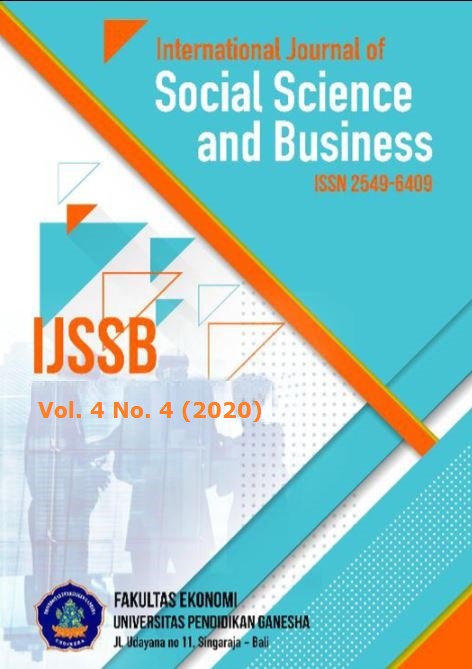Performance Evaluation of Exchange Traded Fund in The Indonesia Stock Exchange
DOI:
https://doi.org/10.23887/ijssb.v4i4.29422Keywords:
Exchange Traded Fund (ETF), Treynor Ratio, Sharpe Ratio, Sortino Ratio, Jensen Alpha, Information Ratio, Omega RatioAbstract
This study aims to evaluate the performance of the Exchange Traded Fund (ETF) index in the Indonesia Stock Exchange by using the Treynor Ratio, Sharpe Ratio, Sortino Ratio, Jensen Alpha, Information Ratio, and Omega Ratio. This research uses a quantitative descriptive approach, and the data source to be applied in this research is secondary data, where the data to be used is the ETF listed on the IDX. The data collection technique will be carried out with a documentation study. There are 12 ETFs to be evaluated. The data used in this study are the weekly closing price and risk-free investment that is represented by the BI rate from January 2018 to December 2019. The result of this study shows that there are only two of the Exchange Traded Fund that has better performance than risk-free investment if it is calculated by using the Sharpe Ratio, Sortino Ratio, Information Ratio, and Omega Ratio. In contrast, the Treynor Ratio and Jensen Alpha show negative value or worse than risk-free investment.
References
Afonso, A., & Cardoso, P. (2019). Exchange-traded funds as an alternative investment option. Notas Económicas, 48(1). https://doi.org/10.14195/2183-203X_48_1
Alkhatib, A., & Harasheh, M. (2018). Performance of Exchange Traded Funds during the Brexit Referendum: An Event Study. International Journal of Financial Studies, 6(3), 64. https://doi.org/10.3390/ijfs6030064
Blitz, D., Huij, J., & Swinkels, L. (2012). Exchange-Traded Funds. European Financial Management, 18(4), 649–662. https://doi.org/10.1111/j.1468-036X.2010.00550.x
Dervishi, B. (2020). Investments and portfolio structure of private pension and insurance companies in North Macedonia. International Journal of Research In Business and Social Science, 9(5), 227–234. https://doi.org/10.20525/ijrbs.v9i5.860
Dorocáková, M. (2017). Comparison of ETF´s performance related to the tracking error. Journal of International Studies, 10(4), https://doi.org/10.14254/2071-8330.2017/10-4/12.
Hartono, J. (2010). Teori Portofolio dan Analisis Investasi (Edisi Sepuluh). In Yogyakarta: BPFE.
Jensen, M. C. (1968). the Performance of Mutual Funds in the Period 1945-1964. The Journal of Finance, 23(2), 389–416. https://doi.org/10.1111/j.1540-6261.1968.tb00815.x
Love, I., & Klapper, L. F. (2003). Corporate Governance, Investor protection, and Performance in Emerging Markets. https://doi.org/10.1596/1813-9450-2818
Low, S. W., & Chin, Y. B. (2013). Refinements to the Sharpe Ratio - Evidence from Malaysian Equity Funds. Global Economic Review, 42(1), 72–97. https://doi.org/10.1080/1226508X.2013.769818
Mikica, D., & Branko, U. (2010). Exchange-traded funds of the eurozone sovereign debt. Ekonomski Anali, 55(187), 31–60. https://doi.org/10.2298/EKA1087031D
Nasution, Y. S. J. (2015). Peranan Pasar Modal Dalam Perekonomian Negara. HUMAN FALAH: Jurnal Ekonomi Dan Bisnis Islam, 2(1), 95–112.
Prasanna, K. (2012). Performance of Exchange-Traded Funds in India. International Journal of Business and Management, 7(23), 122–143. https://doi.org/10.5539/ijbm.v7n23p122
Rita, M. R. (2008). EXCHANGE TRADED FUND (ETF): Inovasi dalam Dunia lndustri Reksa Dana di Indonesia. Jurnal Ekonomi Dan Bisnis, 1, 91–105.
Robiyanto, R. (2017). Performance Evaluation and Risk Aversion Rate for Several Stock Indices in Indonesia Stock Exchange. Jurnal Manajemen Dan Kewirausahaan, 19(1), 60–64. https://doi.org/10.9744/jmk.19.1.60-64
Robiyanto, R. (2018). Performance Evaluation of Stock Price Indexes in the Indonesia Stock Exchange. International Research Journal of Business Studies, 10(3), 173–182. https://doi.org/10.21632/irjbs.10.3.173-182
Rohman Aziz, N., & Shofawati, A. (2019). Pengukuran Metode Rasio Informasi, Rasio Sortino Dan Roy Safety First Ratio Pada Kinerja Reksadana Saham Syariah Periode 2015-2017. Jurnal Ekonomi Syariah Teori Dan Terapan, 6(8), 1644–1659.
Rollinger, T. N., & Hoffman, S. T. (2013). Sortino : A ‘ Sharper ’ Ratio.
Santosa, M., & Sjam, A. (2012). Penilaian Kinerja Produk Reksadana Dengan Menggunakan Metode Perhitungan Jensen Alpha, Sharpe Ratio, Treynor Ratio, M2, Dan Information Ratio. Jurnal Manajemen Maranatha, 12(1), 113086. https://doi.org/10.28932/jmm.v12i1.174
Sharpe, W. F. (1966). Mutual Fund Performance. CHICAGO JOURNALS, 39(1), 119–138. https://doi.org/10.5840/bemag199812115
Sortino, F. A., & Price, L. N. (1994). Performance Measurement in a Downside Risk Framework. The Journal of Investing. https://doi.org/10.3905/joi.3.3.59
Souza, G. S., Penedo, A. S. T., & Pereira, V. S. (2018). Exchange Traded Funds – ETF e fundos mútuos de índice brasileiros: uma comparação de performance e aderência. Estudos Do CEPE, 1(1), 04–22. https://doi.org/10.17058/cepe.v0i0.11530
Timothy, P. (2013). An examination of the relationship between the Economic Freedom Index value and the matching country specific exchange traded fund return. Managerial Finance, 39(7), 677–690. https://doi.org/10.1108/03074351311323464
Treynor, J. L. (1965). How to rate management investment funds. Harvard Business Review. https://doi.org/10.1002/9781119196679.ch10
Wahdah, R., & Hartanto, J. (2012). Analisis Pengukuran Kinerja Reksa Dana Saham di Indonesia. Jurnal Manajemen Dan Akuntansi, 13(April), 35–44.
Wulandari, P. A. (2013). Evaluasi Kinerja Reksadana Saham Indonesia. Jurnal Intekna, 3, 227–234.











